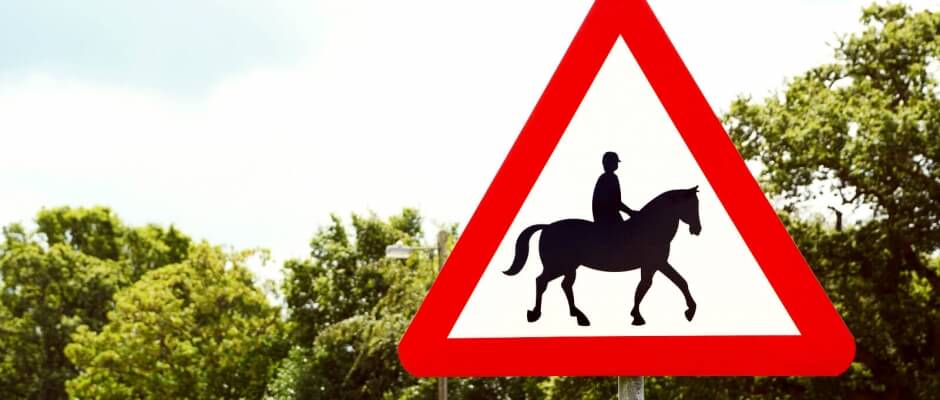There are an estimated three million horse riders in the UK, with many of these regularly using the roads. Not only are horses vulnerable road users, but they can be unpredictable and easily frightened, so the potential for injury and vehicle damage should an accident occur is significant.
What roads are horse riders allowed on?
While you’re (hopefully) unlikely to spot a horse on a busy dual carriageway, the only road type that horse riders can’t use is the motorway. Riders are also prohibited from using footpaths, pavements or cycle lanes.
Horse riders are also technically allowed to use roundabouts but The Highway Code recommends they avoid them.
Gov.uk recommends horse riders use bridleways and equestrian crossings where possible.
How can I prepare myself for encountering a horse rider on the road?
If you’re driving on a narrow rural road, you see road signs warning you that there may be horse riders (like the one above), or you know you’re near a horse riding centre, keep to a safe speed and stay alert. Avoid any distractions in the car such as loud music.
Did you know, country lanes and rural roads are the most dangerous road types, with 59% of all fatalities occurring on country roads. Always look out for hazards ahead and drive at a slow enough speed that you could stop suddenly if necessary. Read more.
Take extra care when approaching bends, as there might be a horse rider up ahead that you can’t see until the last minute.
What should I do if I see a horse ahead?
The Horse Sense guide from THINK! offers the following advice for drivers:
- Make sure you slow down and get ready to stop if you need to
- Avoid any sudden noises – never beep your horn or rev your engine
- Look out for any signals from the rider(s)
- Watch out for any sudden movements from the horse(s)
- When you overtake, drive very slowly and give the horse(s) lots of room.
- Once you have passed the horse(s), keep a slow speed until it is out of sight, then accelerate up again gradually.
Also bear in mind that when a horse rider turns right, they will stay on the left side of the road until they reach the turning, so always look out for signals from the rider as it may not be immediately obvious what they’re doing.
The Horse Rider Safety guide from The Royal Society for the Prevention of Accidents reminds motorists that horse riders are often children – so both the horse and its rider might be nervous of traffic. You should therefore always be patient and courteous when you encounter a horse rider on the road.
What if there’s a horse rider on a roundabout?
Horse riders should stay left until reaching their exit, when they will signal left.
The rider might also signal right to make it clear they are not using a certain exit.
Just like the advice above, drive slowly and give the horse(s) plenty of room. Don’t overtake until it’s safe to do so.
What should I do if I have an accident involving a horse rider?
- Stop the car in a safe place
- Turn on your hazard warning lights if appropriate
- Don’t put yourself in danger – stay away from moving traffic
- Call 999 as soon as it’s safe to do so, and ask for the police to attend. Depending on the severity of the accident it may also be necessary for the fire services to attend. If anyone is hurt, ask for an ambulance
- If the rider is hurt, once you’ve asked for an ambulance, carry out any basic first aid that you can. Read our guide for advice on this
- Be careful when approaching the horse, it will probably be very scared and unpredictable
- Stay at the scene long enough for any affected parties to exchange details with you. Once it’s safe and appropriate, try and write down as many key details about the accident as possible. Our guide has more information on this
- Speak to your insurance company as soon as you can after the accident.
Resources
The following articles have been referenced in this post and may be of use to you:
- What to do if you have an accident
- What to do if you hit an animal while driving
- First aid advice for drivers
- Guide to driving on rural roads
